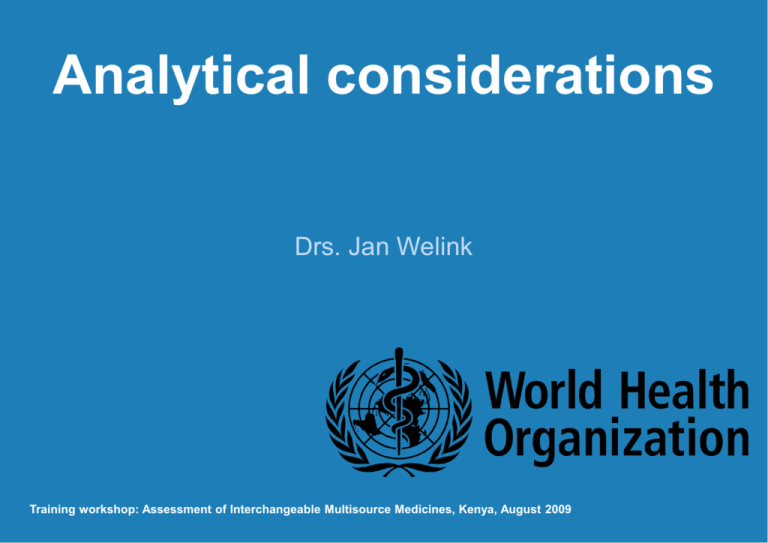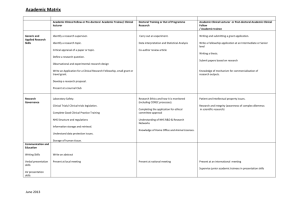Analytical considerations
advertisement

Analytical considerations Drs. Jan Welink Training workshop: Assessment of Interchangeable Multisource Medicines, Kenya, August 2009 Guidance FDA Guidance for Industry – Bioanalytical method validation, May 2001 ICH Guidance for industry – Validation of analytical methods: definitions and terminology, June 1995 – Validation of analytical procedures: methodology, November 1996 2| Assessment of Interchangeable Multisource Medicines, Kenya, August 2009 GCP/GLP GCP/GLP compliance – Clinical studies have to be performed under conditions complying with the principles of Good Clinical Practice, and for analytical methods and sample data handling conditions complying with the principles of Good Laboratory Practice are required. – For older studies without statement of compliance with the above mentioned principles, the assessor should rely on the quality of the submitted report. 3| Assessment of Interchangeable Multisource Medicines, Kenya, August 2009 Choice of method Method used for the determination of drugs and/or metabolites should be: Sensitive Accurate Discriminative Precise 4| Assessment of Interchangeable Multisource Medicines, Kenya, August 2009 Sensitivity Method should be able to quantify the drug in the sampled specimen at least 10 % of the maximum concentration reached after dosing. Limit of Quantification (LOQ): 1/10 Cmax 5| Assessment of Interchangeable Multisource Medicines, Kenya, August 2009 Discriminative The method should be able to discriminate between the selected analyte and interfering compounds from the environment or from other compounds administered simultaneously 6| Assessment of Interchangeable Multisource Medicines, Kenya, August 2009 Accuracy The method must be accurate enough to measure the true value (concentration) of the analyte in a relative small sample 7| Assessment of Interchangeable Multisource Medicines, Kenya, August 2009 Precision The analytical method should be precise enough to reveal identical results when the procedure is applied repeatedly to multiple aliquots of a single homogeneous volume of the biological matrix 8| Assessment of Interchangeable Multisource Medicines, Kenya, August 2009 Validation To measure is to know! 9| Assessment of Interchangeable Multisource Medicines, Kenya, August 2009 Validation Specificity Range Detection limit (LOD) Accuracy Quantification limit (LOQ) Precision Linearity Robustness 10 | Assessment of Interchangeable Multisource Medicines, Kenya, August 2009 Validation-specificity Investigation of specificity should be conducted during the validation phase of the assay The procedures used to demonstrate specificity should be clearly reported Must be applied with structurally similar materials Choices base on scientific judgements 11 | Assessment of Interchangeable Multisource Medicines, Kenya, August 2009 Validation-specificity 12 | Assessment of Interchangeable Multisource Medicines, Kenya, August 2009 Validation-LOD Various methods possible visual evaluation • minimum level at which the analyte can be detected reliably signal-to noise • 3:1 ratio is acceptable standard deviation of the slope and response • LOD = 3.3 σ / S – σ = standard deviation of the response – S = slope of the calibration curve 13 | Assessment of Interchangeable Multisource Medicines, Kenya, August 2009 Validation-LOQ Based on signal-to noise – Reliable quantification is a 10:1 ratio Based on SD of the response and the slope – LOQ = 10 σ / S • σ = standard deviation of the response • S = slope of the calibration curve 14 | Assessment of Interchangeable Multisource Medicines, Kenya, August 2009 Validation LOQ, LOD and SNR Limit of Quantitation Limit of Detection Peak B LOQ Signal to Noise Ratio Peak A LOD Baseline 15 | noise Assessment of Interchangeable Multisource Medicines, Kenya, August 2009 Validation-LOD/LOQ Recommended data: The LOD and LOQ and the method used for the LOQ should be presented The limits should be validated by the analyses of a suitable number of samples prepared at the LOD and LOQ limits 16 | Assessment of Interchangeable Multisource Medicines, Kenya, August 2009 Validation-linearity Should be evaluated across the range of concentrations expected during the study A minimum of five concentrations used in the range is recommended The correlation coefficient, y-intercept slope of the regression and residual sum of squares should be submitted Deviations from the regression line should be analysed for evaluating linearity 17 | Assessment of Interchangeable Multisource Medicines, Kenya, August 2009 Validation-linearity 18 | Assessment of Interchangeable Multisource Medicines, Kenya, August 2009 Validation-range The specified range is derived from linearity studies and should cover the extremes of the concentrations probably reached during the study The range should be justified in the report based on scientific information 19 | Assessment of Interchangeable Multisource Medicines, Kenya, August 2009 Validation-accuracy Accuracy should be assessed on samples spiked with known amounts of the analyte Accuracy should be assessed using determinations over a minimum of 3 concentration levels (low, medium and high) Accuracy should be reported as percent recovery from the added amount 20 | Assessment of Interchangeable Multisource Medicines, Kenya, August 2009 Validation-accuracy 21 | Assessment of Interchangeable Multisource Medicines, Kenya, August 2009 Validation-precision Repeatability – concentrations covering the specified range Intermediate precision – Like days, analysts, equipment Reproducibility – Determined if analyses take place in separate periods 22 | Assessment of Interchangeable Multisource Medicines, Kenya, August 2009 Validation-accuracy/precision Accuracy/precision: 23 | Assessment of Interchangeable Multisource Medicines, Kenya, August 2009 Validation-accuracy/precision Between-day: Intra-day: 24 | Assessment of Interchangeable Multisource Medicines, Kenya, August 2009 Validation-accuracy/precision: Accuracy/precision calibrators: 25 | Assessment of Interchangeable Multisource Medicines, Kenya, August 2009 Validation-accuracy/precision FDA Accuracy within-run 26 | between-run Precision within-run between-run normally: <15% normally: <15% LLOQ: <20% LLOQ: <20% Assessment of Interchangeable Multisource Medicines, Kenya, August 2009 Validation-robustness Robustness should be considered during development phase Shows the reliability of the analytical method with respect to variations in the method parameters In case variations occur they should be suitably controlled and if present adequately tested and documented 27 | Assessment of Interchangeable Multisource Medicines, Kenya, August 2009 Validation-robustness Typical examples: Stability of the analytical solutions – Influence of variations of pH of the mobile phase – Influence of variations of mobile phase composition – Influence of temperature and flow rate Extraction conditions – pH and extraction time 28 | Assessment of Interchangeable Multisource Medicines, Kenya, August 2009 Validation-robustness 29 | Assessment of Interchangeable Multisource Medicines, Kenya, August 2009 Validation-recovery Recovery: Extraction efficiency analytical method – consistent – precise – reproducible Recovery: 80% 75% 91% 97% 65% 73% 30 | mean: 81.1% CV: 14.7% Assessment of Interchangeable Multisource Medicines, Kenya, August 2009 Recovery: 15% 16% 13% 15% 16% 14% mean: 14.8% CV: 7.9% Validation-stability Stability assessed prior subject sample analysis! Required data – – – – – 31 | Freeze and thaw stability Short term temperature stability Long term stability Stock solution stability Post preparation stability Assessment of Interchangeable Multisource Medicines, Kenya, August 2009 Analysis clinical samples The analytical method should be validated before the start of obtaining clinical samples. Each analytical run should contain sufficient QC samples at the beginning, middle and end at at least 3 levels (LQC, MQC and HQC). QC 32 | QC QC QC Assessment of Interchangeable Multisource Medicines, Kenya, August 2009 QC QC Analysis clinical samples Acceptation or rejection of a run should be predefined before the actual start of the analysis of the clinical samples. FDA criteria QC 33 | QC QC QC Assessment of Interchangeable Multisource Medicines, Kenya, August 2009 QC QC Analysis clinical samples All samples of 1 subject in 1 run Subject sample reanalysis should be predefined before the actual start of the analysis of the clinical samples. Reasons: - improper sample injection - mail function - concentration > HLOQC - unexpected value - PK reason QC 34 | QC QC QC Assessment of Interchangeable Multisource Medicines, Kenya, August 2009 QC QC Analysis clinical samples - unexpected value - PK reason 35 | Assessment of Interchangeable Multisource Medicines, Kenya, August 2009 Report All methods should be covered by adequate Standard Operating Procedures (SOP’s) for general and analysis specific procedures Before the start of an analytical procedure an adequate study plan has to be written or be incorporated in the study protocol 36 | Assessment of Interchangeable Multisource Medicines, Kenya, August 2009 Report A specific detailed description of the bioanalytical method should be written All experiments used to make claims or draw conclusions should be presented in the report GLP compliance/inspections/audits 37 | Assessment of Interchangeable Multisource Medicines, Kenya, August 2009 End 38 | Assessment of Interchangeable Multisource Medicines, Kenya, August 2009



